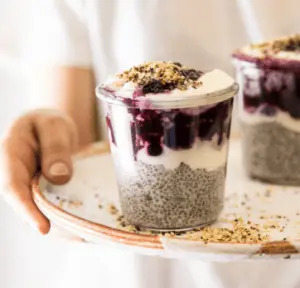Last month, Export Connect – in partnership with Investment NSW and the Department for Trade and Investment South Australia – hosted an inbound buyer mission featuring Jagota Thailand. Following the Market Insights Presentation, valuable first-hand insights were shared about the Thai market. Let’s take a look!
About the Buyer: Jagota
Jagota, established in Thailand in 1997, is a significant distributor serving customers of all sizes across the country via retail and foodservice channels. With logistical infrastructures in Phuket and Samui, Jagota can fully cater to customers in those regions as well. With its trendsetting and customised food solutions, Jagota is well-known for being one of the most innovative and creative food companies in Thailand. Jagota presently represents a multitude of brands across various product categories, including dairy, meat, seafood, snacks, and groceries.
Q&A Session Insights
Question 1: From your perspective, what are the key economic factors, consumer trends and channel trends in Thailand?
There’s some good news coming out of Thailand. This is the first year where we’re really getting back to normal. We’re seeing tourist numbers returning to what they were pre-COVID because people are eager to travel to Thailand–so the numbers are back. For Thailand, this is great news, because the economy largely relies on tourists coming in. There are two key tourist demographics coming to Thailand. You have huge groups, for instance, from China, that naturally don’t spend that much money, but also Western tourists or Australians coming back that have the funds and spend money in Thailand. I was part of a study with the Thai Ministry of Tourism in 2009, where they were predicting tourist numbers for Thailand up until 2020. At that time, they predicted there would be 20 million tourists in Thailand per year by the year 2020. By 2016, tourist numbers were already at 35 million! And we’re now reaching 40 to 45 million in Thailand this year. So it’s all back, and it’s growing. And it’s very important for Thailand. So, with tourism back, that’s a key economic factor.
Of course, like every country, we’re talking about inflation. In markets like Malaysia, there are low or no duties, and in Thailand, the duties on Australian products are also relatively low. But for competing exporters from areas like Europe, they usually have very high duties, which multiply throughout the supply chain – producers are increasing their prices, and shipping and freight costs are increasing as well. On top of this, there are high duties, which can reach up to 20%, 30% or even higher on European products. Hence, Australia has an advantage as tariffs in Thailand are much lower, and sometimes non-existent. This gives Australian exporters a competitive advantage compared to other exporters to Thailand. That’s an important economic factor to keep in mind. So, it’s up to Australian exporters to take advantage of this. Aside from tourism and tariffs, everybody is facing inflation and higher prices – these challenges will likely persist in the short-term.
Question 2: Which food and beverage categories present the strongest opportunities in Thailand?
I’ll talk a bit about Jagota, and what we’ve identified as opportunities. As I mentioned earlier, snacks is a key category. This includes snacks with functional properties. While they don’t have to be organic, functional claims are very important. You also need to have a very attractive offering–from the attractive packaging to an attractive product that tastes good. If you don’t have this, it will be very hard because competition is extremely strong at the moment from exporters from around the world. This makes developing a unique and tempting offering key to gain entry into the market.
Question 3: What are the biggest challenges and barriers for Australian food and beverage exporters seeking to enter the Thai market?
The biggest challenge is the competition. Everyone wants to get into Thailand, and competition is much stronger than other markets, such as Malaysia. Aside from that, the other barrier would be FDA registration. But talking specifically about trade and market entry barriers, these are very limited. There are some items in the vegetable range that you can’t bring into Thailand, but that’s very few. Aside from that, if you are an organised operation, you have your licences and you communicate clearly and effectively with stakeholders like distributors and importers, then there should be no significant trade barriers into Thailand.
However, pricing could be an issue. You need to be competitive against other imported products, so you need to hit the right price point. This often comes down to communicating with your importer in the market. With us at Jagota, we give feedback on recommended price points based on information such as typical retailer margins, and of course, our margins as well. It’s important to undertake a proper feasibility study ahead of time and align your expectations with those of your importers, distributor and retailer. Once they’re aligned, then you can get moving.
Question 4: Now, you touched on the FDA. If you compare Thailand and Malaysia, for a lot of products, it’s a lot easier to get into the Malaysian market. The registration process is generally quicker unless you’ve got the halal requirements which can be quite extensive. But in my experience working through the Thai FDA, you’ve got to have all your facts, your data, your flowcharts. It can be quite expensive and it can be quite a lengthy process. Can you talk a bit about that?
The registration process is very important. In Malaysia, it’s very straightforward as they have JAKIM (their local halal authority). So if you have halal certification that is accepted by JAKIM, all you need to do is download a list of Australian halal bodies which are recognised by Malaysia and then you’re good to go. That’s more or less your main licence that you need aside from, of course, ISO or HACCP certification.
For Thailand, there’s a bit more to it. We have an FDA in Thailand as our authorities are attempting to implement the same standards as Western countries such as Australia and those in Europe. So it’s a pretty straightforward process. It should not take too long, however the length and complexity of the process varies across product categories. For example, if tomato sauce comes in a glass jar with a metal lid, there’s acidity inside which could affect the metal. Those kinds of things take longer because Thai authorities will need to perform lab tests. However, regular consumers products that are generally risk-free are usually registered within two to three weeks. This can be done online and once your documents are complete, your registration number is granted and then you can implement that on your labels and the rest of the process is fairly easy.
Question 5: What advice would you give to a potential exporter seeking to enter the Thai market?
Get in touch with your preferred importers. Talk with them, try to understand them. Get involved. Don’t stop after the first win, like the first shipment, because that’s not where the work stops. The first shipment, the first listing is very easily done. Usually money is paid by someone so that you can actually list the product in the supermarket. But the first shipment is not a sufficient measure of success–success is when you have repeated shipments, when you build a relationship with a supplier and when you actually have a common goal. And I think this is the most important thing. Get involved. If you’re not able or willing to commit, then don’t. And especially in Thailand, you need to be in it for the long haul. Because you’ll face a lot of competition from all over the world and as I said, everybody wants to get into Thailand, so be prepared for that.
We hope you’ve found these insights on the Thai market helpful. As always, if you’ve got any questions or want to discuss export opportunities for your company, feel free to drop us a line at Export Connect – we’d love to hear from you.




